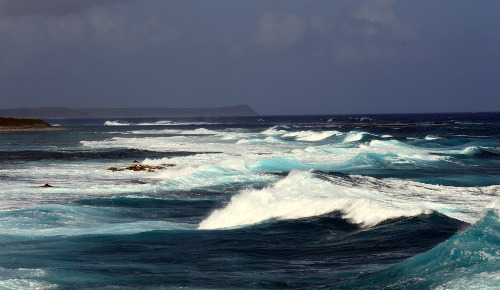
Human activities, in particular greenhouse gases and anthropogenic aerosols, have an influence on sea surface temperatures in the Atlantic Ocean and as a consequence on a number of important climate phenomena such as African droughts, precipitation, the Atlantic hurricane activity or summertime climate over North America and western Europe. A study by CMCC Foundation recently published provides new perspectives on the international scientific debate summarized and presented by Nature journal.
It’s like a periodic oscillation, a fluctuation in sea surface temperatures in the North Atlantic basin, with a typical 60–70-yr time scale, termed AMV – Atlantic Multidecadal Variability or AMO – Atlantic Multidecadal Oscillation to remind to its apparent oscillatory behavior.
The phenomenon is not only interesting from an academic point of view, but also for its impacts on the climate across a large area. This fluctuation reverberates in fact in a number of hydro-climatic phenomena: rainfall variability over the Sahel and African droughts of the 1980s, the current high levels of Atlantic hurricane activity, Mediterranean surface temperatures or summertime climate over North America and western Europe have been associated with AMV.
Its predictability, that is our capability in the future to understand its dynamics and evolution, is therefore very important.
The origin of this fluctuation is at the core of a contentious issue. According to a widely accepted picture, the AMV is driven by the internal variability of the Atlantic climate system, in particular by changes in atmospheric and ocean circulation. Another perspective is that at least the most – recent AMV cycle is driven by external forcings that are outside the North Atlantic climate system, both natural (solar forcing variability, volcanic aerosols) and anthropogenic (anthropogenic aerosols, that is suspended particles such as organic pollutants, sulphates, carbonaceous aerosols dust, and greenhouse gases) factors.
The study of CMCC researchers Alessio Bellucci and Silvio Gualdi “The Role of Forcings in the Twentieth-Century North Atlantic Multidecadal Variability: The 1940–75 North Atlantic Cooling Case Study” contributes to the discussion while providing some evidence for this second hypothesis: the results suggest a significant influence of anthropogenic aerosols and greenhouse gases on Atlantic Multidecadal Variability and in particular in the 1940-75 North Atlantic cooling.
CMCC researchers inspected the origins of multidecadal variability in the North Atlantic sea surface temperatures while focusing on a specific event: they targeted, in particular, the 1940–75 ‘‘warm-to-cold’’ transition and evidence is found for a significant influence of anthropogenic agents on multidecadal sea surface temperature fluctuations across the Atlantic sector, suggesting that anthropogenic aerosols and greenhouse gases might have played a key role in the 1940–75 North Atlantic cooling.
“For this study”, Alessio Bellucci, first author of the study, explains, “we used CMIP5 ensembles that have been already used to support the last IPCC report AR5. There were some studies suggesting a significant role for anthropogenic aerosols in determining the North Atlantic multidecadal variability, but they were based on simulations performed with a single model and for this reason their results had been countered. ”
The added value of the CMCC study is represented by its “hierarchic” approach. The
following key question is addressed: What are the relative roles of internal and externally forced variability on the observed mid-twentieth-century North Atlantic cooling?
“To answer this question”, Bellucci explains, “we use a large ensemble of CMIP5 uninitialized integrations of the historical period performed under a hierarchy of forcing conditions. More in detail, we used standard simulations for all forcings, natural and anthropogenic, simultaneously, and a subset of some idealized simulations for selected combinations of anthropogenic and/or natural forcing agents. Our aim was to highlight the relative roles of natural and anthropogenic factors.”
The results have clear implications for decadal predictability and predictions, a new field of climate prediction. Whereas seasonal predictions are important to study some processes like El Niño, decadal predictions are important to study climate evolution on multiannual to decadal timescales. Researchers were used to think that anthropogenic emissions have an influence on climate evolution only in the context of the long-term climate evolution and trend, but recent studies highlighted that they play an important role also in the context of the mid-term, that is on multiannual to decadal timescales.
“This new emerging perspective”, Bellucci concludes, “suggests that the uncertainty associated with alternative aerosol and greenhouse gas emission scenarios should be duly accounted for in designing a common protocol for coordinated decadal forecast experiments.
Model responses will be very different, in fact, depending on the different scenarios adopted.”
For further information:
- Find out all the results of the CMCC study: read the integral version of the article “The Role of Forcings in the Twentieth-Century North Atlantic Multidecadal Variability: The 1940–75 North Atlantic Cooling Case Study”
- The article published by Nature “Origins of Atlantic decadal swings”: a summary of the topic and two perspectives on the debate on Atlantic Muldidecadal Variability
- The study authored by Booth et al. (2012), the first study to suggest a significant role for anthropogenic aerosols in determining the North Atlantic multidecadal variability


